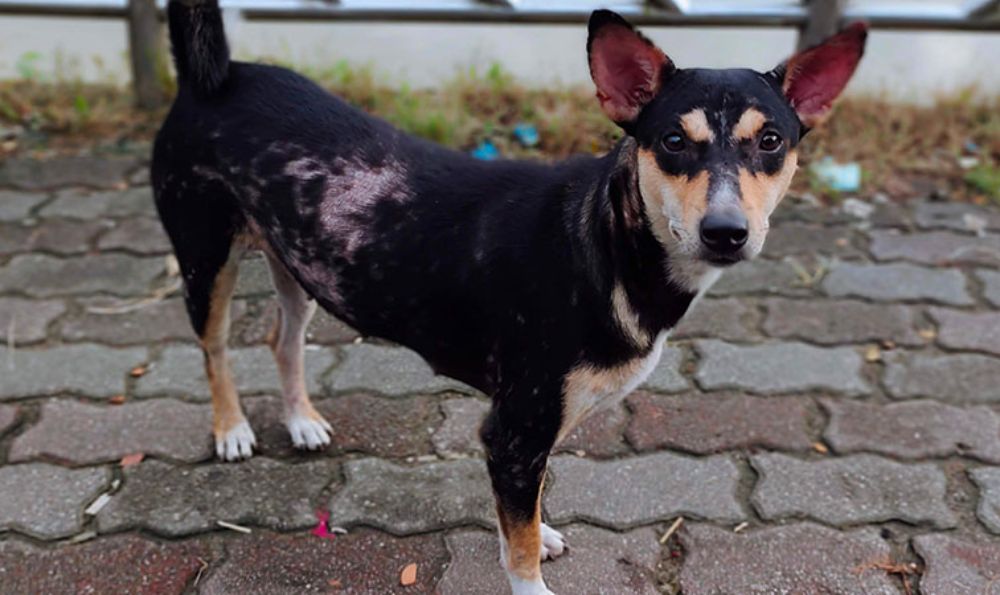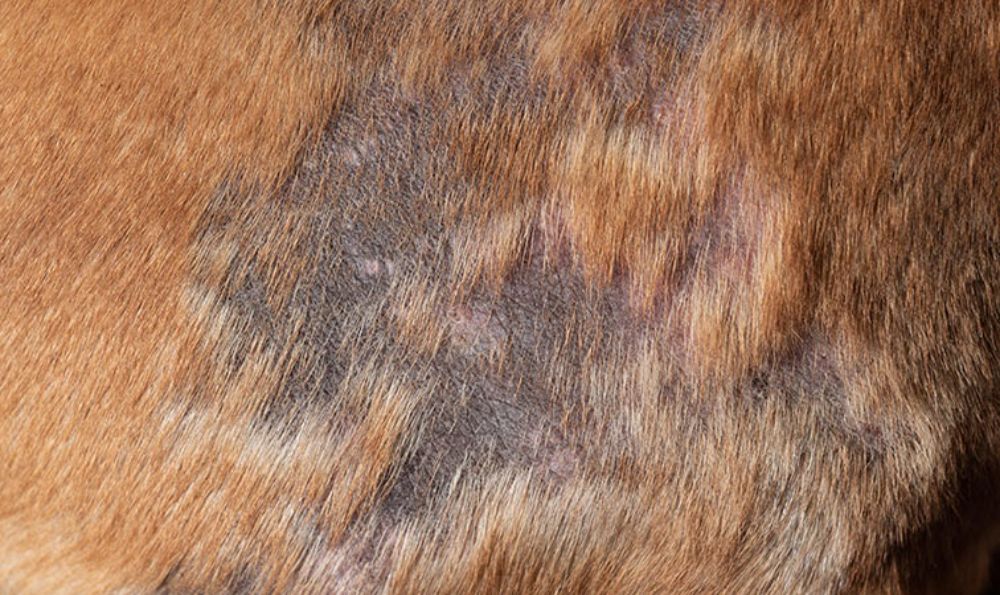
Dog mange is a highly contagious skin condition that’s caused by mites and normally results in hair loss and itching. The term ‘mange’ is derived from the French word ‘Mangeue’, meaning “to eat or itch”. There are different types of mange in dogs, caused by different kinds of mites, some of which can affect humans.
So if you need to get under the skin of mange in dogs, and how it can affect your pup, here's all the information on dog mange.
What Is Mange on Dogs?
Mange mange is a skin disease caused by mites, that's some itchy business! There are two main types of mange that can affect dogs, sarcoptic and demodectic. They’re caused by different types of mites but have similar symptoms. Infected dogs will show the most obvious symptoms of hair loss and itching.
The early stages of mange in dogs can be mistaken for other conditions because the mites can’t be seen by the naked eye. The same symptoms can be seen with other skin conditions and parasites. The first sign you’re likely to notice is your dog scratching lots, which you may mistake for fleas.
Sarcoptic Mange in Dogs
Sarcoptic mange, also known as canine scabies, is one of the most common mange on dogs and is highly contagious. It’s caused by Sarcoptes scabiei mites, which burrow beneath the skin to lay eggs. The eggs hatch into larvae within 3-10 days of being laid, and then move about feeding on the skin as they grow into adult mites.
Adult sarcoptic mites live for 3-4 weeks and can transfer between dogs through direct contact or on items like bedding. They can also be found on foxes, so may be transferred to your dog if they venture into a fox den.
Sarcoptic mites can be transferred to humans causing skin irritation, but this will be short-lived as they're unable to complete their life cycle on humans. To reduce the risk of catching mites if your dog is infested, keep them off your furniture, avoid close contact with them and wash their bedding and soft toys regularly. To avoid passing the mites onto other dogs, avoid close contact with other dogs and keep your dog on lead during walks.
Symptoms of sarcoptic mange include hair loss, redness, inflammation, and scabs or crusty skin. Mites prefer hairless areas, so are drawn to the insides of the ears, belly and armpits. As the mites burrow into the skin and begin laying eggs, it causes irritation for the dog, and they’ll scratch and bite the affected areas. If left untreated, mange can cause deep skin infections and swollen lymph nodes.
Demodectic Mange in Dogs
Demodectic mange, also known as red mange, is caused by Demodex canis mites which live in the dog’s hair follicles. A few demodectic mites are present on most dogs, but the number is kept under control if the dog has a healthy immune system.
Demodectic mange only affects dogs with a compromised or immature immune system as the mites are then able to rapidly increase. It mostly affects dogs under 18 months when the mites are passed from mother to puppy.
All puppies receive the mites from their mother, but only ones with underdeveloped immune systems will be affected by mange. Older dogs that have a weakened immune system due to illness, medication, or malnutrition, are also susceptible.
Demodectic mange and mites are not contagious to other animals or humans. Mites can be passed on to other dogs, but the condition will only affect those with compromised immune systems. In most cases of mange, as the dog ages and their immune system matures, their body will be able to fight the condition without any medication. However, a dog with an immune deficiency will require treatment.
The main symptom of demodectic mange is hair loss, usually starting around the face. The disease may be localised (just a few patches of hair loss) or generalised (many areas of hair loss). Dogs are unlikely to find it itchy unless there’s a secondary infection, which can also cause a smell. There’s also a condition known as Demodectic pododermatitis where only the paws are affected by the disease.
How Do Vets Diagnose a Dog with Mange?

Dog mange is difficult to diagnose. Skin scrapings can be taken to examine under a microscope, but the mites can be difficult to collect, especially sarcoptic mites as they burrow deep into the skin. Bood tests can be done too, but they’re not very reliable. Most cases of mange are diagnosed and treated based on the symptoms – mostly hair loss and itching.
Mange Treatment for Dogs
Treating a dog with mange is relatively easy but does require a trip to the vets. Sarcoptic manage can be treated with oral medication, a spot-on or shampoo to kill the mites. Your dog may need two or three treatments to make sure all the mange mites have been killed. They’re usually spaced 2-3 weeks apart to allow any eggs to hatch.
Your vet may also prescribe a steroid cream and antibiotics if your dog has any open sores. You’ll also need to wash any bedding, brushes, toys, or soft furnishings that your dog has access to just in case there are any mites living on them.
The best way to prevent your dog from getting Sarcoptic mange is to regularly apply flea treatment as it’s also effective against the mange mites. Also avoid areas where there’s a high population of foxes.
Demodectic mange that isn’t related to an immune deficiency can be treated with creams or left to resolve on its own. Usually, a puppy’s immune system matures as it ages and is then able to fight off the mange and prevent further mite infestation. Older dogs that develop the disease are harder to treat but can be managed with ongoing treatment. Medication for any secondary infections may also be prescribed.
As all dogs have some Demodex canis mites living on them, the best prevention for Demodectic mange developing is to keep your dog fit and healthy through exercise, a high-quality diet, clean environment and regular vet health checks.
Sarcoptic and Demodectic mange are the two most common types of mange found on dogs. They’re both difficult to diagnose through tests but have obvious symptoms such as hair loss and itching. Fortunately, you can treat a dog for mange relatively easily. Cleaning your home and separating infected pets from other household members will help to prevent further infestation and transference onto other family members.
Everypaw Dog Insurance
Everypaw's Dog Insurance comes with 24/7 unlimited access to vets and vet nurses that can help with your pet's health, care, nutrition and behaviour. So you can rest assured your pup will be well looked after.
Content provided from Vetstream's Vetlexicon Canis - www.vetstream.com/treat/canis
Vetlexicon is the world’s largest peer-reviewed online clinical reference source. All our content is written and peer-reviewed by over 1,000 of the world’s leading veterinarians, ensuring relevance, accuracy and quality.
- Campbell K, Scarff D & Godfrey D (online) Skin: sarcoptic mange. In: Vetlexicon Canis. Vetstream Ltd, UK. Website: https://www.vetlexicon.com/treat/canis/diseases/skin-sarcoptic-mange
- Campbell K & Godfrey D (online) Skin: demodectic mange. In: Vetlexicon Canis. Vetstream Ltd, UK. Website: https://www.vetlexicon.com/treat/canis/diseases/skin-demodectic-mange